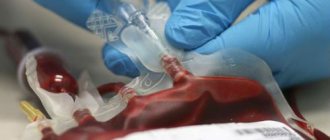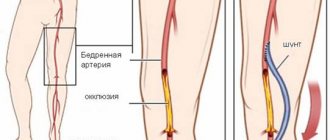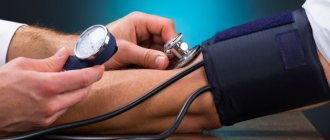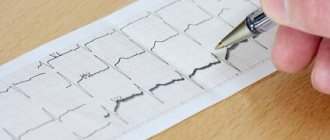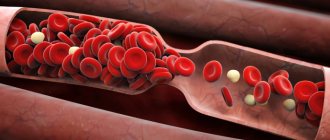Hemorrhagic pancreatic necrosis is changes in the pancreas, expressed by the death of its cells without the ability to recover.
Acute hemorrhagic pancreatic necrosis develops as a result of acute pancreatitis or chronic exacerbation of inflammation of the pancreas. All this leads to nonspecific stress of the body with disruption of functional systems.
Acute pancreatitis is a closed-type inflammation that occurs during mechanical and surgical injuries of the demarcation type of pancreas, which is based on the death of pancreatocytes, self-destruction of enzymes, followed by necrosis and degeneration of the gland, and the addition of a secondary purulent infection.
With all the development of medicine, this disease has a very high mortality rate, overall from 7 to 15% and in destructive forms from 40 to 70%.
The reason for the development of pancreatic necrosis lies in the loss of the protective function of the pancreas from the destructive effects of pancreatic enzymes. The aggression of enzymes, the level of which is extremely high, leads to partial or total cell death. The pancreatic area is affected; its cells produce enzymes that are part of pancreatic juice. They have a negative effect on the cells of the organ and break down its proteins. Some injure the walls of blood vessels, which causes hemorrhages. This process is called autoaggression of pancreatic enzymes. The speed of damage depends on the amount of enzymes that penetrate the pancreas through the lymph and bloodstream.
Necrotic areas formed by dead tissue
After some time, dead tissue forms necrotic areas, inflammation and enlargement of the pancreas occurs. This poses a huge threat not only to human health, but also to human life. The immune system declines, the digestive process is disrupted, and the body refuses to function independently.
General information
Pancreatic necrosis (necrosis of the pancreas) is a destructive disease of the pancreas, which is a serious complication of acute or chronic pancreatitis .
The ICD-10 code for pancreatic necrosis is K86.8.1. A characteristic feature of this formidable disease is the gradual necrosis of pancreatic tissue. This is a very dangerous diagnosis that poses a threat to human life. The death of this organ occurs due to the fact that the pancreatic tissue is dissolved by the enzymes that it itself produces. As a rule, this process is combined with other pathological phenomena - inflammatory processes, infection, etc.
This disease is the most severe complication of pancreatitis. As a rule, it affects young people of working age. According to medical statistics, this disease accounts for about 1% of all recorded cases of acute abdomen. However, the number of cases of this disease has been increasing recently. The high mortality rate with pancreatic necrosis is also alarming - it is 30-80%. Therefore, it is extremely important to diagnose the disease in a timely manner and begin adequate treatment immediately.
Diagnostics
Questioning and examination: most often the diagnosis can be verified at the stage of collecting an anamnesis (typical signs - recent consumption of large amounts of alcohol, fatty foods). Severe pain in the left hypochondrium, vomiting, palpation of the infiltrate in the pancreas are important symptoms for making a diagnosis.
Laboratory diagnostics:
- general blood test - performed routinely, allows you to identify general signs of inflammation in the body (leukocytosis, accelerated ESR);
- general urinalysis - a sharply increased level of amylase indicates inflammatory or necrotic processes in the pancreas;
- biochemical blood test - with pancreatitis/pancreatic necrosis, an increase in the level of pancreatic enzymes is detected: amylase, lipase, trypsin and others;
- tests to assess the exocrine function of the pancreas - PABA test, Lund test, etc.;
- stool analysis to determine the presence of enzymes and assess digestion.
Instrumental diagnostics:
- Survey radiography of the abdominal organs is a simple graphical research method. Allows you to identify indirect signs of inflammation, swelling of the pancreas, large foci of necrosis;
- Ultrasound is a quick and accurate method for determining inflammatory and necrotic changes in the pancreas;
- MRCP - magnetic resonance cholangiopancreatography. Using a magnetic tomograph to examine the entire hepatopancreatic system (liver, bile ducts, gallbladder, pancreas and its ducts). The method is extremely accurate and non-invasive;
- Diagnostic laparoscopy is an invasive research method. The anterior abdominal wall is punctured with a hollow tube through which a video camera is passed. When performing such a procedure, the surgeon can directly assess the current state of the pancreas on the monitor screen.
The final diagnosis of pancreatic necrosis can be established only after a histological examination of pancreatic tissue.
In most cases, patients with pancreatic necrosis are in extremely serious condition and require constant care in the intensive care unit. The use of invasive diagnostic methods is often impossible due to the risk of worsening the course of the disease.
Pathogenesis
The basis of the pathogenesis of pancreatic necrosis is a failure in the mechanism of internal protection of the pancreas from the influence of pancreatic enzymes that destroy it. If a person drinks alcohol heavily and constantly overeats, external secretion increases significantly, the ducts of the gland are stretched, and the outflow of pancreatic juices is disrupted.
Necrosis of the pancreas develops against the background of pancreatitis - an inflammatory process of the pancreas, in which the death of part or the entire organ often occurs.
The pancreas is an organ important for the normal functioning of the body. Its main functions are the production of the main enzymes involved in digestion, as well as the regulation of blood sugar due to the production of the hormones insulin and glucagon . Accordingly, dysfunction of this organ leads to serious disturbances in the general condition of the body.
When a person feels hungry, juices and enzymes are transported through the connecting duct into the small intestine, which ensures enzymatic processing of food. Pancreatic fluid acts on the acidic environment of gastric juice, neutralizing it. In the intestines, digestive enzymes break down and process substances.
The pancreas produces the main digestive enzymes:
- lipase – breaks down fats;
- amylase – converts starch into sugar;
- chymotrypsin , trypsin - are involved in the breakdown of proteins;
- glucagon , insulin , polypeptide , etc.
If in healthy people the enzymes produced by the pancreas are active directly in the digestive tract, then in patients with damage to the ducts of the gland, the enzymes directly affect the pancreas. Against the background of increased pressure inside the ducts, edema of the parenchyma develops, the acini of the pancreas are destroyed, and proteolytic enzymes are activated prematurely. As a result, the gland “poisons” itself. Due to the activation of lipase, necrosis of fat cells occurs, under the influence of elastase, blood vessels are destroyed, and activated enzymes, as well as breakdown products, end up in the bloodstream. In this case, there is a toxic effect on all tissues and organs. First of all, damage occurs to the liver, kidneys, heart, and brain.
With pancreatic necrosis, three stages of tissue death are determined:
- Toxemic - toxins of bacterial origin appear in the blood, the gland actively produces enzymes.
- Development of an abscess - a purulent inflammatory process of tissues and organs that surround the pancreas develops.
- Purulent changes in tissues - if purulent sepsis develops, immediate surgical intervention is required, as this condition is life-threatening.
General information about the disease
Pancreatic necrosis is a complication of acute pancreatitis (inflammation of the pancreas), consisting in varying degrees of death of cells in this organ and the development of severe clinical symptoms.
Pancreatic necrosis is not a disease of alcoholics! As a rule, with chronic alcohol consumption, chronic pancreatitis develops with a gradual loss of exocrine pancreatic function. Pancreatic necrosis, most often, occurs with occasional intake of large volumes of ethanol-containing drinks and animal fats.
Etiology
- Consumption of significant amounts of alcohol and fatty foods (more than 95% of all pancreatic necrosis).
- Gallstone disease, decompensation of biliary dyskinesia.
- Acute surgical pathology of another organ (penetration due to gastric ulcer, etc.)
- Acute poisoning by chemicals.
- Traumatic injury to the pancreas.
- Congenital malformations of the pancreas.
- Shock (septic, hemorrhagic, traumatic - a condition leading to multiple organ failure).
- History of surgical interventions (adhesive disease).
- Iatrogenic pancreatic necrosis (a rare phenomenon when acute pancreatitis and pancreatic necrosis develop after endoscopic examination of the gland).
Pathogenesis
A significant intake of ethyl alcohol and animal fats into the digestive tract leads to hyperfunction of the pancreas. If a person has problems with the outflow of pancreatic juice from the gland, a huge number of highly active pancreatic enzymes (phospholipase, trypsin, chymotrypsin, elastase and others) are suddenly activated.
First, trypsinogen is released from damaged cells, transforming into trypsin, and kallikrein and kallidin are activated. When exposed to these enzymes, histamine and serotoxin are released, which activate blood protein factors (Hageman and plasminogen).
Due to damage to the microvasculature of the pancreas, all enzymes penetrate into the general bloodstream and cause general vascular spasm (for a short period), after which dilatation (expansion) of blood vessels occurs, the permeability of the vascular walls increases, blood plasma freely leaves the vascular bed, and edema develops pancreas (at this stage, internal bleeding often occurs in the retroperitoneal space). As in any organ system, a slowdown in blood flow (stasis) leads to the formation of blood clots - thrombi.
Vascular thrombosis leads to dysmetabolic disorders in cells (hypoxia, acidosis), and areas of necrosis form in the pancreatic parenchyma. Lipases (enzymes that break down fat molecules) are released from dying cells. A large number of lipases can provoke necrosis not only in the pancreas, but also in the omentum, fatty tissue of the retroperitoneal space, etc.
In addition to local damage, general intoxication develops due to the effect of pancreas enzymes on systemic vessels. Inadequate vascular tone leads to circulatory disorders in other organs, cellular and organ degeneration, acid-base, water-electrolyte disorders develop, protein synthesis, carbohydrate and fat metabolism slow down. Without pathogenetic correction with pharmacological drugs, multiple organ failure develops
An important link in the development and severity of pancreatic necrosis are protease inhibitors - special blood proteins that protect against the effects of one’s own and foreign proteolytic enzymes (including the pancreas) on cellular metabolism. The greater the concentration of protease inhibitors and their binding capacity, the less pronounced the development of pancreatic necrosis will be. This function is individual for each organism and is determined genetically, which is why the clinical picture of pancreatitis is so varied.
Classification
According to the prevalence of necrosis:
- focal - necrosis of one anatomical area of the pancreas: head, body, tail or parts thereof;
- diffuse (segmental) - all parts of the pancreas are affected (not only the parenchyma, but also the vessels, ducts, and nerves).
According to the depth of the lesion:
- superficial - necrosis of the outer layers of the gland. Usually ruptures when the superficial pancreatic ducts rupture, when juices containing proteolytic enzymes accumulate between the outer surface of the pancreas and its capsule;
- deep - necrosis of more than half of the pancreas, part of the tissue remains viable;
- total - death of the entire organ. Often the process moves to the omentum and retroperitoneal fatty tissue.
According to the nature of the clinical course:
- abortive course - a moderate form of pancreatic necrosis. Tissue (interstitial) edema develops around the foci of necrosis. Compensatory inhibitory systems cope with the amount of vasoactive enzymes released from the gland, spontaneous recovery occurs (subject to drug treatment);
- progressive course - the concentration of vasoactive enzymes in the blood exceeds the compensatory abilities of the body. Deep or total necrosis of the gland develops, hemodynamic disturbances, multiple organ failure, there is a high probability of sudden pancreatogenic shock, spontaneous internal bleeding and further infection of the pancreas;
- regressive course - the clinical symptoms of pancreatic necrosis gradually “fade away” within 20 – 30 days. Against the background of pancreatic edema, pseudocysts (connective tissue capsules with pancreatic fluid) form. Sometimes pseudocysts reach significant sizes, which leads to displacement of the stomach, gall bladder, and liver with disruption of their functions;
- relapsing course - typical for people suffering from alcoholism. A special clinical form that develops against the background of chronic dystrophic changes in the pancreas with periods of sudden exacerbation. Relapses in this case are repeated several times during a lifetime and become more and more severe, often leading to death;
- fulminant pancreatic necrosis is the most dangerous form. Necrosis of the gland and the clinical picture develop over several hours. Hemodynamic disturbances, multiple organ failure and shock develop rapidly. Mortality rate is about 90%.
According to the mechanism of occurrence:
- hypersecretory is the most common form. It is formed against the background of excessive release of pancreatic enzymes due to consumption of alcohol and fatty foods;
- traumatic - develops against the background of blunt abdominal trauma, surgical interventions, diagnostic procedures;
- biliary - against the background of a violation of the outflow of bile from the liver (cysts, tumors, developmental abnormalities). With this option, pancreatic necrosis is often complicated by the addition of a bacterial infection and the development of phlegmon of the fatty tissue of the retroperitoneal space;
- mechanical - due to obstruction of the common bile duct and disruption of the flow of bile into the duodenum, the pancreas begins to produce an increased amount of pancreatic juice, which destroys it;
- immune - autoimmune inflammation of the pancreas (destruction of pancreas cells by its own lymphocytes) gradually leads to its death;
- contact - develops against the background of a complicated peptic ulcer of the stomach or duodenum (penetration of the ulcer);
- vascular - this form is typical for people suffering from atherosclerosis and other vascular diseases (usually the elderly). Gradual vascular stenosis leads to blood stasis and the development of dysmetabolic disorders in the pancreas.
According to clinical form:
- hemorrhagic pancreatic necrosis - large-focal or total necrosis of the pancreas. It develops extremely quickly and is accompanied by a pronounced clinical picture (multiple organ failure). High lethality;
- fatty pancreatic necrosis - the formation of foci of necrosis that merge with each other, a connective tissue capsule is formed around it. Without drug therapy, it becomes hemorrhagic;
- mixed pancreatic necrosis.
According to the presence of complications:
- uncomplicated;
- complicated (infection, bleeding, shock, etc.).
According to severity:
- mild degree - isolated foci of necrosis in the gland;
- medium degree - large foci of necrosis without fusion;
- severe degree - total necrosis of the pancreas;
- extremely severe degree - complicated total necrosis.
Classification
Depending on the predominance of damaging mechanisms, three forms of the disease are determined:
- Adipose – with increased lipase activity, pancreatic adipose tissue is destroyed. After lipase appears outside the pancreatic capsule, it acts, provoking the appearance of areas of necrosis in the layers of the peritoneum, the greater and lesser omentum, the mesentery, and internal organs. aseptic peritonitis and multiple organ failure subsequently develop .
- Hemorrhagic - with increased elastase activity, microcirculatory disorders predominantly develop, resulting in vasospasm . For a short time - several days, and sometimes hours - toxemia provokes paresis of the vascular wall, vasodilation, and blood flow in the gland tissues slows down. This leads to a sharp increase in the likelihood of blood clots and, later, ischemic necrosis . Initially, the vascular wall is destroyed thicker than the pancreas, and later in other organs. The consequence of all these processes is hemorrhage into the retroperitoneal tissue and internal organs. The main symptom that characterizes hemorrhagic pancreatic necrosis is effusion into the abdominal cavity with the presence of blood in it. The disease develops rapidly, so in doctors’ reports you can often see the conclusion: “The cause of death is hemorrhagic pancreatic necrosis.”
- Mixed - with approximately the same activity of elastase and lipase, the signs of fat necrosis and hemorrhagic imbibition are equally pronounced.
Depending on the prevalence of pathological manifestations, two forms are defined:
- local (one area affected);
- diffuse (two or more areas are affected).
Depending on the rate of progression:
- progressive;
- sluggish.
Depending on the depth of the lesion:
- surface;
- deep;
- total.
Depending on the course of the disease:
- recurrent;
- progressive;
- retrogressive;
- fulminant;
- abortive.
Depending on the severity of the manifestations of the disease, several of its degrees are determined:
- Mild degree - as a rule, this is edematous or diffuse necrosis with small foci.
- Medium degree - diffuse or local with more pronounced foci.
- Severe degree - diffuse or total with large foci.
- An extremely severe stage - pancreatic necrosis is accompanied by complications leading to irreversible consequences and death.
Classification and types
From the affected area:
- limited necrosis (small, medium, large);
- widespread necrosis (subtotal and total), part of the gland is affected in full.
According to the presence of infection:
- infected;
- sterile (fatty - the process is slow, with a positive prognosis, hemorrhagic pancreatic necrosis - active course of the disease, causes internal bleeding, mixed necrosis).
From the behavior of the disease:
- abortive;
- progressive.
Causes
A number of factors that provoke necrotic processes in pancreatic tissues are determined:
- regular excessive consumption of alcohol;
- constant overeating, abuse of smoked, fried and fatty foods;
- peptic ulcer;
- gallstones;
- the presence of abdominal injuries and previous surgical interventions in this area;
- severe infectious diseases.
Under the influence of these factors, pancreatic dysfunction can develop, which leads to pancreatitis and pancreatic necrosis. But, as a rule, pancreatic necrosis manifests itself against the background of occasional alcohol intake. Studies have confirmed that in most cases, pancreatic necrosis developed after an episode of drinking alcohol in very large quantities.
Treatment of the disease
The risk group includes:
- elderly people, aggravating their situation with concomitant diseases;
- alcoholics;
- drug addicts;
- those who abuse fatty foods (sometimes a single large intake is enough);
- people with acute gastrointestinal diseases;
- with pathologies of the liver and pancreas;
- people with abdominal injuries.
Treatment of pancreatic necrosis occurs only in a hospital, and often in the intensive care unit
Self-medication for similar symptoms with folk remedies is strictly prohibited; this option is only possible when the body is restored after progressive treatment methods and strictly under the supervision of a doctor.
Stages of patient stabilization:
- To remove pain - use antispasmodics and analgesics in the form of no-shpa, papaverine, they can offer platiphylline hydrotartate and ketane. They practice novocaine blockade by administering a solution of novocaine with glucose or promedol with atropine and diphenhydramine sulfate;
- Suspend the aggressive action of pancreatic enzymes - intravenous infusions and drip infusions of contrical or trasylol, an alternative is gordox, pantrypin, and also use fluorafur and ribonuclease;
- To eliminate spasms by increasing the patency of the gland ducts, reducing the volume of gastric juice and extinguishing its alkaline environment - a strict diet at the level of fasting, atropine or ephedrine is used, sometimes cimetedine with quamatel is used. Somatostatin is given to reduce the secretion of gastric juice and blood flow in the internal organs, to stop bleeding.
- Block the spread of infection and toxins - antibiotics such as kanamycin or gentamicin, also cephalexin or zeporin. Toxins are removed by infusion therapy using glucose plus insulin, Ringer's solution, and saline.
- In advanced forms and extensive lesions, we will talk about surgical intervention. Without accompanying infections, laparoscopic drainage of the abdominal cavity is performed. Otherwise, intracorporeal (intra-abdominal) blood renewal (peritoneal dialysis) is performed.
Total hemorrhagic pancreatic necrosis, aggravated by infection, requires resection of the pancreas or a more radical operation - pancreatectomy, removal of the pancreas. This intervention is used extremely rarely, as it is very traumatic and entails a high mortality rate. Another radical solution to the problem is sequestrectomy (removal of dying areas).
Often, postoperative necrosis continues and a repeat operation is necessary.
During the operation, neighboring organs may also be affected, which can lead to increased complications and poor prognosis. Treatment of this disease takes a long time, from several weeks to 6 months, after which the patient is registered at a dispensary and is required to undergo a medical examination twice a year.
Many years of practice have shown that conservative treatment methods for infectious diseases are less effective and should be used in addition to the main surgical intervention.
Features of treatment conditions
- Ambient temperature (well-ventilated room);
- Following a fasting diet;
- Immobilization to block the spread of toxins throughout the body;
- Gastric lavage with cool water.
Symptoms of pancreatic necrosis
Signs of this disease may appear several hours or days after the influence of factors provoking the disease has been noted.
The main symptom is pain manifested in the left hypochondrium. Also, pain can radiate to the sides, back, and be felt in the pit of the stomach. The pain is constant, quite intense or moderate. It can be encircling, radiating to the shoulder, scapula, so a person may have the impression that a heart attack . The pain becomes stronger after the patient eats. This may cause nausea and repeated vomiting. Pancreatic necrosis without pain is impossible.
The following symptoms of pancreatic necrosis are also likely:
- redness of the skin, as due to damage to the pancreas substances that dilate blood vessels enter the blood;
- flatulence is a consequence of rotting and fermentation in the intestines;
- bluish or purple spots on the abdomen, buttocks and sides - the so-called Gray-Turner symptom ;
- gastrointestinal bleeding is a consequence of the destructive effect of enzymes on the walls of blood vessels;
- temperature increase;
- tension of the anterior abdominal wall, pain on palpation;
- dry mucous membranes, skin, thirst are a consequence of dehydration;
- decreased blood pressure ;
- confusion, delirium.
The disease, as a rule, begins acutely, and most often patients associate its first signs with excessive alcohol consumption and a significant violation of the diet. Doctors testify that most of these patients are admitted to hospitals while still intoxicated, which confirms the rapid development of pathological changes in the gland. There is a direct relationship between the severity of pain and the severity of necrosis. If destructive changes spread to the nerve endings, this leads to a gradual decrease in the severity of pain. But this sign, combined with intoxication, is quite alarming in terms of prognosis.
After pain appears, after some time the patient begins to experience vomiting. She is difficult to tame and does not bring relief. The vomit contains blood clots and bile. Due to constant vomiting, dehydration develops, which leads to dry skin and a coated tongue. Diuresis gradually slows down. Flatulence, stool and gas retention are noted. These symptoms are accompanied by fever .
Due to fluctuations in glucose levels, toxemia and hyperfermentemia, the brain is affected and encephalopathy .
If the inflammatory process progresses, the pancreas increases significantly in size. An infiltrate forms in the abdominal cavity. This condition is life-threatening for the patient.
Manifestations of pancreatic necrosis
The development of the disease occurs in stages:
- The first is that bacteria actively develop in the pancreas, causing toxinemia and increased autoaggression of pancreatic enzymes. Fever, vomiting, and unstable stools begin.
- The second - purulent and enzymatic breakdown of gland cells begins, with the formation of failures in the organ.
- Third, inflammation spreads to neighboring tissues, causing a stress response in the body.
It manifests itself as acute girdling pain, radiating to the left side of the body. This disease does not exist without pain. Accompanied by uncontrollable vomiting, which does not bring relief, with the release of bile and blood particles. Dehydration develops, the skin and mucous membranes dry out, the tongue becomes coated, and the volume of urine decreases. Gas formation increases and stool becomes irregular.
Pancreatic necrosis is always accompanied by pain
When examining the patient, bloating is observed in the abdomen, and blue or purple spots also appear on the sides, around the navel, and on the buttocks. This is a sign of bleeding in the gastrointestinal tract, as elastase (an enzyme) destroys blood vessels.
A high level of vasoactive components in the blood, affecting the tone and diameter of the lumen of blood vessels, leads to redness of the face. But with collapse, on the contrary, pallor is visible. The skin may become earthy gray with a yellow tint. Severe intoxication leads to frequent shallow breathing. Confusion, disorientation, agitation, possible coma due to fluctuations in glucose levels - these are all symptoms of pancreatic necrosis.
The inflammatory process enlarges the pancreas and leads to the appearance of accumulations in the tissues of cellular elements with particles of blood and lymph.
Inflamed pancreas
Complications of pancreatic necrosis can be a nonspecific stress reaction of the body (multiple organ failure), a rapid decrease in circulating blood, which leads to hypovolemic shock, liver damage, pleuropulmonary complications, purulent inflammation of the retroperitoneal tissue and pancreas, pancreatic fistulas, inflammation of the peritoneum, bleeding.
Tests and diagnostics
If you suspect the development of necrosis, you should immediately consult a general practitioner. The specialist conducts an examination and determines the circumstances surrounding the development of the disease. He must palpate and determine the presence, nature and location of pain. If a pathology of the gland is suspected, the patient is examined by an endocrinologist. If tumors are detected on the gland, an oncologist is also involved in the treatment process.
To establish a diagnosis, instrumental and laboratory examinations are prescribed.
Laboratory studies include an extensive blood test, since with necrosis the following pathological changes are noted:
- Increased sugar levels, increased granularity of leukocytes , neutrophils.
- Increased ESR .
- Increased levels of elastase, trypsin, hematocrit as a result of dehydration.
- Increased liver enzymes due to inflammation.
- The development of necrosis is also indicated by an increased level of amylase in the urine.
- In the process of laboratory tests, the state of hormones and digestive enzymes is determined.
Also during the diagnostic process, the following studies may be prescribed:
- Ultrasound examination - to determine the uneven structure of gland tissue, identify cysts, abscesses, fluid in the abdominal cavity, stones in the bile ducts. Ultrasound also makes it possible to analyze the condition of the ducts.
- Magnetic resonance imaging, computed tomography - allow you to determine the foci of disease development, the size of the organ, and also find out whether inflammation is developing, whether there are swelling, abscesses, neoplasms, deformities.
- Angiography of gland vessels.
- Diagnostic laparoscopy.
- Puncture.
A specialist will be able to make a final diagnosis only after receiving data from all prescribed studies.
Establishing a diagnosis
Often, patients arrive with acute pain and attribute their ailments to poisoning or the negative effects of diet or alcohol abuse.
General clinical blood and urine tests are the basis for diagnosing any disease
After examining the patient, the doctor prescribes the following tests:
- blood test for the level of pancreatic enzymes - trypsin, chymotrypsin, elastase, designed to break down protein in food;
- urine for the detection of trypsinogen and uroamylase;
- gastric juice on the level of acidity;
- probing to detect enzymes and bicarbonates in pancreatic juice;
- stool for detection of fats;
- determination of the composition of air in the lungs;
- studies using contrast agents of the biliary and pancreatic systems;
- necrosis puncture.
Additionally, to identify the diagnosis and establish the affected area, laparoscopy, ultrasound and CT of the abdominal organs, and MRI may be prescribed.
Treatment with folk remedies
When a patient's pancreatic necrosis worsens, he experiences severe pain. Folk remedies that are used in parallel with the main treatment can help improve the condition a little. But, before practicing such methods, it is necessary to visit a doctor, establish a diagnosis and begin practicing the correct treatment regimen.
- The fruits of Japanese Sophora - a decoction is prepared from them. A spoonful of raw materials should be filled with 1 tbsp. boiling water and leave for 5 hours. Drink warm before every meal. The course of treatment is 10 days.
- Blueberry berries and leaves - a decoction is prepared from them by pouring boiling water over dried or fresh raw materials and boiling for 5 minutes. (2 tbsp. raw materials per 250 ml of water). Drink instead of tea.
- Immortelle herb - a decoction helps relieve pain and inflammation. To prepare the decoction, take 1 tbsp. l. dry herbs and a glass of water, cook for 5 minutes. Strain the resulting broth and drink throughout the day.
- Oat decoction helps relieve irritation and restore organ cells. To prepare the product, you need to soak the grains and wait a few days for them to sprout. Sprouted grains need to be dried and ground. Pour the mixture with cold water (1 tablespoon of oats per 1 glass of water) and leave for about half an hour. You need to drink 2 glasses of this product a day.
- Lemon – helps reduce pain. To do this, boil the lemon in water for 5 minutes, then squeeze the juice out of it and mix with raw yolk. Drink the product on an empty stomach and do not eat for three hours after it. Take it five times a day, once every three days. The course of treatment lasts several months.
- Licorice root - to prepare it you need to take 1 tbsp. l. chopped dry licorice root, the same amount of dandelion and burdock leaves. Pour the mixture with 2 cups of boiling water, drink the infusion hot, half a glass 3-4 times a day.
There are also special herbal mixtures used to treat the pancreas. But it is important to take into account that they bring benefits to the body if such preparations are taken regularly and according to the scheme approved by the doctor. Under no circumstances should you practice self-medication with folk remedies for such a terrible diagnosis as pancreatic necrosis.
Surgery
The operation involves removing dead tissue and cleaning the abdominal cavity. Intervention is indicated if the patient has a total or subtotal infection of an infectious nature, a purulent abscess, false cysts, or peritonitis.
If the disease proceeds without infection, surgery is avoided.
Surgeons prefer to resort to minimally invasive techniques, since open abdominal surgery has a high mortality rate and is often accompanied by secondary infection.
Prevention
To prevent pancreatic necrosis, you need to follow some simple recommendations:
- Limit the amount and frequency of alcohol consumption.
- Avoid junk food – fast food, processed foods, soda, and minimize the consumption of fatty and fried foods.
- Do not take medications without a doctor’s prescription, especially do not abuse them.
- Try to create a diet based on natural products, try to practice split meals in small portions.
- Treat cholelithiasis in a timely manner.
- At the first symptoms indicating problems with the pancreas, consult a doctor immediately.
- Follow the principles of a healthy lifestyle.
Symptoms
The clinical picture of pancreatic necrosis includes:
- sharp, unbearable pain localized in the left part of the epigastric region, radiating to the scapula and shoulder;
- feeling of dry mouth;
- the appearance of a thick light coating on the tongue;
- nausea and vomiting that does not bring relief;
- flatulence, bloating;
- loose stools;
- hyperemia or pallor of the facial skin;
- irritation of the peritoneum, accompanied by the appearance of purple spots on the skin of the abdomen;
- sudden changes in blood pressure;
- tachycardia, shortness of breath;
- impaired diuresis;
- mental disorders (motor agitation or inhibition of reactions).
The clinical picture of pancreatic necrosis includes sudden changes in blood pressure.
Diet for pancreatic necrosis
Diet for pancreatic necrosis of the pancreas
- Efficacy: therapeutic effect after 21 days
- Timing: constantly
- Cost of products: 1800-1900 rubles. in Week
Diet Table No. 5p for pancreatitis
- Efficacy: therapeutic effect after 14 days
- Timing: constantly
- Cost of products: 1400-1500 rubles. in Week
In the first days of treatment for this disease, it is necessary to practice therapeutic fasting. The doctor determines its duration individually. Next, you need to adhere to a strict diet, completely eliminating salty, fatty, smoked, sweet, fried foods, as well as alcohol from the menu. The list of prohibited products is quite wide. You cannot consume cabbage, figs, grapes, bananas, bell peppers, onions, garlic, coffee, cocoa, sausages, canned food, fatty fish, soda, mushrooms, jam, fresh bread, egg yolk, ice cream, millet and barley cereals, and baked goods.
During this period, you are allowed to eat the following foods:
- boiled vegetables;
- porridge with water - oatmeal, rice, semolina, buckwheat;
- lean meat - veal, chicken;
- dairy products;
- baked fruits;
- crackers;
- refined vegetable oils – 10 g per day;
- vegetarian soups with potatoes, carrots, zucchini, pumpkin.
Your doctor will help you create the right diet. This diet must be strictly followed for about a month. If the dynamics are positive, the diet is gradually expanded.
Nutrition after surgery should be supervised by a specialist for the first time. Before the operation, the patient does not eat at all. A day after surgery, he is prescribed parenteral nutrition, using special solutions with a complex of nutrients. Such solutions contain fatty acids, amino acids , minerals, and vitamins. About a week after the operation, the patient begins to have food administered through a tube into the stomach.
Then, after some time, the patient gradually switches to a gentle diet, in which carbohydrates are the basis of the diet, and fats are kept to a minimum. Food needs to be chopped and eaten small and little by little. You should not overeat; the menu should include only boiled and steamed food.
Treatment
All patients with pancreatic necrosis should be hospitalized in the intensive care unit!
During the first 5–7 days after the onset of the disease, surgical treatment is not performed, since it is impossible to accurately assess the extent of pancreatic necrosis. This significantly increases the risk of worsening pancreatic necrosis, infection, and the development of arrosive bleeding.
The patient needs strict bed rest and complete rest. Pharmacological therapy is carried out:
- detoxification therapy (correction of water-salt and protein balance) - administration of colloid and crystalloid solutions intravenously;
- analgesic therapy - administration of painkillers (including narcotic and mixed ones), antispasmodics, novocaine blockades;
- antibiotic therapy - to prevent infectious complications;
- hepatocardioprotectors - drugs to protect the liver and heart;
- symptomatic therapy - correction of urination, defecation, neurological and vascular disorders.
Surgical treatment involves excision of necrotic areas of the pancreas, drainage of the retroperitoneal space with antiseptic solutions, and installation of drains for fluid outflow. The postoperative period is usually long.
Pancreatic necrosis of the pancreas, the prognosis after surgery in most cases is questionable. The patient’s further quality of life depends on many factors: the amount of gland necrosis, the speed of medical care, the presence or absence of complications, age and concomitant diseases. Postoperative patients require long-term follow-up with a gastroenterologist and surgeon.
Consequences and complications
Pancreatic necrosis is a dangerous disease, and if it develops rapidly, the patient may die within 24 hours after its onset. Whether a person can survive fat necrosis depends on how affected the gland is, how widespread the damage is, and how large the area of edema is.
With pancreatic necrosis, the following consequences are possible:
- rupture of the biliary tract;
- cerebral edema;
- damage to lung tissue;
- bleeding and, as a consequence, decomposition of the pancreas and stomach;
- peritonitis;
- peptic ulcer;
- enzyme deficiency;
- intoxication of the gastrointestinal tract;
- thrombosis of venous arteries;
- pancreatic fistulas;
- pancreatic cyst;
- suppuration in the pancreas;
- state of shock.
In addition, necrosis of the pancreas can lead to diabetes mellitus , rectal or pancreatic cancer.
Complications
The complications are:
- massive toxemia (toxic, pancreatic shock) - a significant entry of pancreatic enzymes into the general bloodstream leads to irreversible disorders of blood circulation, nervous regulation and death;
- purulent complications - infection of the damaged pancreas can lead to the formation of abscesses and phlegmon of the retroperitoneum, peritonitis, pleural empyema, sepsis;
- bleeding - under the influence of aggressive enzymes, arrosive internal bleeding often occurs (an extremely unfavorable prognosis, since surgical intervention for hemostasis itself can destabilize the patient’s condition);
- Exocrine and endocrine pancreatic insufficiency are complications of the late period. These complications can be successfully corrected using pharmacological therapy.
Prognosis for pancreatic necrosis of the pancreas
It is important to understand that pancreatic necrosis is a very dangerous disease, and, unfortunately, the chances of surviving pancreatic necrosis depend on many circumstances. The likelihood of survival is reduced by old age, delays in seeing a doctor, arterial hypertension in the patient, the presence of other dangerous diseases, etc.
The prognosis for pancreatic necrosis after surgery with timely treatment is as follows: mortality is about 50%. After surgery for severe forms of necrosis, mortality can reach 95%. Therefore, early contact with a doctor increases the chances of successful treatment.
Relevance of the problem and epidemiology
The most pressing problems of surgery remain: early prognosis of the occurrence of pancreatic necrosis, prevention of infection of the pancreas, diversity of the clinical picture (difficulties in quickly making a diagnosis), choice of surgical tactics at the early stage of pancreatic necrosis.
Another problem is the social aspect - patients’ awareness of the risk factors and the scale of this pathology. That is, deviations from the doctor’s preventive instructions are one of the most common causes of the development of acute pancreatitis and pancreatic necrosis.
List of sources
- Dibirov M.D., Yuanov A.A. Pancreatic necrosis. Diagnostic and treatment protocol. Educational and methodological manual. Moscow, 2012, p. 366
- Ermolov A.S., Ivanov P.A., Blagovestnov D.A. and others. Diagnosis and treatment of acute pancreatitis. M., 2013, “VIDR”, p. 382
- Mitryakov P.S. Modern methods of treating patients with pancreatic necrosis // International Journal of Experimental Education. – 2021. – No. 9-2. – P. 221-224;
- Acute pancreatitis (Diagnosis and treatment protocols) / S.F. Bagnenko [and others]; St. Petersburg Research Institute of Emergency Medicine named after. I.I. Dzhanelidze. - St. Petersburg, 2004.
- Savelyev V.S., Filimonov M.I., Burnevich S.Z. Pancreatic necrosis. MIA, 2008, p. 259
- Sakhno V.D., Mainulov A.M., Vlasova N.V., Bochkareva I.V. Necrotizing pancreatitis, treatment protocols. Annals of Surgical Hepatology, 2005, vol. 10, no. 1, p. 107 – 112
Diet
Pancreatitis requires a diet, and pancreatic necrosis of the pancreas requires an even more strict diet.
If surgery is indicated, then a few days before and a few days after it, the patient is transferred to clinical nutrition: intravenous or tube feeding. This is necessary to reduce enzyme activity as much as possible. At the same time, patients receive food enriched with proteins, vitamins and antioxidants.
After recovery, the patient will have to go on a strict diet forever. Alcohol, fatty, fried, smoked, spicy, sweet, canned food, too cold or too hot food are prohibited.
Causes of the disease
The medical theory of the occurrence of this dangerous disease has not reached a consensus on the causes that cause it. But medical practice suggests that the following factors provoke the appearance of hemorrhagic pancreatic necrosis:
- if inflammation of the pancreas previously occurred, which led to a partial loss of its functions;
- if the output of pancreatic juice is impaired;
- if there has been global poisoning as a result of alcohol or chemicals;
- if infectious diseases of the bile ducts have occurred: cholangitis, cholecystitis, etc.;
- if blood clotting increases as a result of past viral diseases, therapeutic effects using chemicals;
- if the body has autoimmune pathologies of the hemorrhagic type;
- if the parenchyma of the gland is injured due to mechanical actions, for example, surgical penetrations;
- if oncology was treated with chemotherapy or radiation, and against this background DIC syndrome occurred.
These reasons disrupt the functioning of the acinus, which is responsible for the production of enzymes. Gastroenterologists have revealed from the results of studies that one of the important roles in the occurrence of pancreatic necrosis is played by a violation of humoral regulation. This function controls human life through blood, lymph, and other liquid media with the help of hormones

